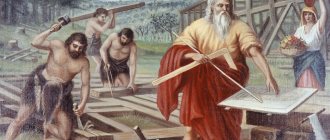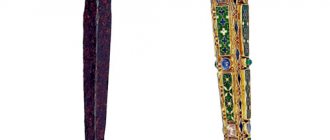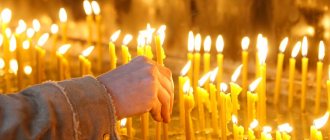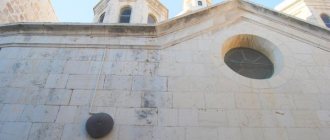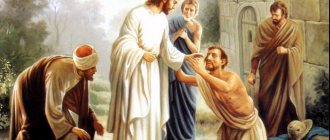| xxxMatthew 27:33-56; Mark 15:22-41; Luke 23:33-49; John, 19:17-37 The crucifixion of Christ is described in all four versions of the Gospel, but these descriptions differ from each other. Therefore, it is not surprising that the depictions of the crucifixion scene are so different in their details. It is generally believed that when Christ was brought to Golgotha (the place of execution), his clothes were torn off and he was crucified. His cross was placed between the crosses on which two thieves were crucified at the same time. Then Pilate forced a sign to be made with the inscription “Jesus of Nazareth, King of the Jews” and nailed to the cross. Having crucified Christ, the soldiers cast lots to see who would get his clothes: “...to each soldier a piece and a tunic; the tunic was not sewn, but entirely woven on top.” The crowd continued to mock the crucified Christ, telling him: “... if You are the King of the Jews, save Yourself.” St. Luke and St. Mark claim that the thieves crucified with Christ also cursed Him. St. Luke says that one of these thieves reproached the other, saying: “And we are justly condemned, because we received what was worthy of our deeds; but He did nothing bad.” Then he turned to Christ: “... remember me, Lord, when you come into your kingdom” (Luke 23:41-42). After hanging on the cross for many hours, Christ became thirsty. And then one of the crowd took a sponge, soaked it in vinegar and, tying it to a reed, gave it to Christ to drink. All the Gospels agree that several women were present at the scene of the crucifixion: among them were Mary the mother of Christ, Mary the mother of St. James the less, and Mary Magdalene. Of all the evangelists, only St. John claims that he was present at the crucifixion of Christ and that Christ, before his death, entrusted his mother to his care. After Christ’s death on the cross, one of the soldiers pierced His side with a spear and “immediately blood and water flowed out.” This soldier is usually identified with the centurion, who, having witnessed the crucifixion, was convinced of the divine nature of Christ. And when the centurion, “seeing that he had cried out thus, gave up the ghost, he said, Truly this man was the Son of God” (Mark 15:39). In the Christian tradition, this centurion was given the name St. Longinus. The death of Christ on the cross is the central image of Christian art and the visual focus of all Christian thoughts. By His sacrifice on the cross, Christ demonstrated the possibility of human redemption, in other words, His deliverance from the original sin of Adam, inherited by all humanity. The early Church avoided this subject. During the persecution of Christianity in the Roman Empire, the crucifixion of Christ was symbolically represented by a lamb placed next to the cross. Even in the time of Constantine the Great, the cross was depicted without the figure of Christ. The changing nature and reflection of prevailing sentiments and concepts in religious thought. The Crucifixion as a summary (reminder of) Christian teaching. Some of the characteristic features of the Crucifixion are doctrinal in origin. The Middle Ages are a symbolic and allegorical expression of the doctrine. The Counter-Reformation is a simple object of worship, with a laconic image of Christ alone. The Italian Renaissance is a detailed, picturesque and multi-figure retelling of the gospel story. The earliest known images of the Crucifixion date back to the 6th century. They are very rare. The plot became widespread in the Carolingian era (ivory carving, coinage, in illuminated manuscripts). Since that time, accompanying figures and images characteristic of the “Crucifixion of Christ” appear:
In the early interpretation, coming from Byzantium, Christ was depicted as a triumphant Savior - alive with open eyes and wearing a royal crown. From the 11th century a new interpretation of the plot appears, with an emphasis on the suffering of Christ - an exhausted figure, a bowed head, a crown of thorns (a little later). The dominant image in Western art. Medieval authors emphasize the “historical” connection between the Fall and the Crucifixion:
This plot involuntarily encourages a symmetrical composition. There is a clear tendency to place figures in pairs on both sides of the cross. The difference is in the “moral dignity” of the right and left sides, given to virtue and vice. were also crucified:
Basic values: |
See also:
Christian mythology Holy Cross History of the Holy Cross Ascension to the Cross St. Longinus Trinity Crucifixion, cult object
Cross
In the capital of Ancient Rome, crucifixion was a widely used form of punishment for the most base criminals and slaves. It was accomplished, apparently, as follows. At the place of execution, a stipes was dug in - a vertical pillar that could be used more than once. The convict carried a crossbar (patibulum) to the place of execution, to which his hands were tied (to avoid resistance). In place, his hands were nailed at the wrists to the ends of this crossbar, which rose onto the post. With the help of slots and spikes, it was fixed either at the top of the post (most often) or slightly lower. In the first case, the result was a crux commissa (“connected”) or a tau cross (from the Greek letter “T”); in the second - crux immissa (“crossed”). Finally, the legs of the person being crucified were nailed to a vertical post.
Nailing was common, rather than tying, which is typical for the depiction of robbers. Until the 12th century. Traditionally, four nails were depicted - for the hands and for each foot. Subsequently, with a few exceptions, there were three of them (the legs were nailed with one nail). The only mention of them in the Gospel was made by the unbelieving Thomas (John 20:25). Now there are more than twenty nails as holy relics.
The footrest (suppedaneum) is an invention of medieval artists.
In ancient times, an inscription (titulus) indicating the guilt of the convicted person was hung around his neck, and at the place of execution it was attached to the top of the cross. Pilate “wrote the inscription and placed it on the cross. It was written Jesus of Nazareth, King of the Jews (...) in Hebrew, Greek, and Roman.” (John 19:19-20) In Renaissance art it was usually given only in Latin - “Iesus Nazarenus Rex Iudaeorum”, abbreviated: “INRI”. In the painting of the Counter-Reformation it can be seen in its entirety in three languages.
In the art of the 13th century. (occasionally and later) the cross sometimes takes the form of a tree of life (lingum vitae). This plot motif comes from the writings of Bonaventure, who wrote that it was the tree of knowledge, born again through the power of the Savior's blood - another way to reflect the connection between the Crucifixion and the Fall.
Figure of Christ
Artists since the Renaissance have depicted Christ as dead with his head tilted over his shoulder (usually the right one). (“having bowed his head, he gave up his spirit” John 19:30). The crown of thorns began to be often depicted with gray. XIII century, when Louis IX brought holy relics from the crusade to the Middle East. Before the era of the Counter-Reformation, this detail was rarely missed by artists. The Medieval Church discussed the question of whether Christ was naked on the cross (in Ancient Rome it was customary to execute this way). In early eastern depictions of the plot, he wears a long, sleeveless tunic, and sometimes Christ wears thin clothes at his waist. But all these are inventions of artists of the early Middle Ages, like the loincloth (perizonium).
Characters around the cross
- Two robbers
All the Gospels tell about two thieves crucified with Christ. Their names Dismas and Gestas ("good" and "bad") are taken from the apocryphal Gospel of Nicodemus. In Luke, one of them reproached the other that their punishment was deserved, while Christ was innocent. The Savior said to this: “Truly I tell you, today you will be with Me in Paradise.” In fulfillment of the promise, the thief found himself among those saved by Christ during the Descent into Hell. From Luke's account a contrast is drawn between the repentant sinner and the unrepentant. The good one is to the right of Christ, his face is calm and peaceful, and his soul is carried away by an angel. The bad one is on the left, he is tormented, and his soul is in the claws of the demon. John reports that the soldiers broke the robbers' legs to hasten their hour of death. The paintings depict this both explicitly and in the form of blood pouring from the wounds on their legs. This motif is found in German art of the 15th century. The Byzantine manual for artists instructs that the criminal on the right is a gray-haired man with a round beard, and on the left is young and beardless. The early Italian Renaissance followed the Byzantine tradition. In the Middle Ages, robbers (according to the degree of holiness) were written smaller than the Savior. Later in the West, to distinguish them from Christ, they are usually depicted not nailed down, but tied by the armpits to the T-shaped crux commissa, hanging from its crossbar (patibiilum). Sometimes they are blindfolded.
- Warriors with spear and sponge
Legendary characters named Longinus (from the Greek “spear”) and Stephaton. In the Middle Ages they were constantly depicted together on both sides of the cross, with a raised spear (representing the Church) and a cane with a sponge (Synagogue). The first of them is better known: “But when they came to Jesus, when they saw Him already dead, they did not break His legs. But one of the soldiers pierced His side with a spear, and immediately blood and water flowed out” (John 19:33-34). It is surrounded by many legends and speculations. The “Golden Legend” tells of the healing of his blindness with blood from the wounds of Christ, subsequent baptism and martyrdom. Canonized. Longinus's blindness can be indicated by the warrior pointing his pike.
Longinus is identified with the centurion of the Synoptic Gospels (not in John), who exclaimed: “Truly He was the Son of God.” In painting, these characters are often depicted separately: a warrior with a pike and a centurion in military garb (possibly on horseback); he has a look of horror on his face.
Stephaton was depicted somewhat less frequently. All four evangelists noted that the sponge at the end of the cane was soaked in vinegar, which was offered to Christ as a drink just before his death. It is also not uncommon to depict only a spear and a sponge, towering among military weapons.
- Warriors casting lots
The characters are frequent in all periods of the history of Christian art. Usually the fullest description in John is followed (19:23-24). The clothes of the crucified Christ were divided into four parts - “a part for each soldier”; and they cast lots for a tunic cut from a single piece of fabric (“Let us not tear it apart, but let us cast lots for it” (John 19:24).). Warriors are depicted at the base of the cross or in the corner of the picture. Their number varies, but rarely less than three. They throw dice and quarrel. Characteristic images: a soldier with a knife, ready to cut his tunic; a soldier who tries to reconcile quarreling people.
- Virgin Mary and St. John
A very common plot whose typology was established in the 9th century. (Carolingian Renaissance). Illustrates the entrustment of the Virgin Mary by the still living Christ to the Apostle John:
“Jesus, seeing the Mother and the disciple standing there, whom he loved, said to His Mother: Woman! Behold, Your son. Then he says to the disciple: Behold, your Mother! And from that time on, this disciple took Her to himself.” (John 19:26-27)
They are depicted with bowed heads on the right - the Virgin Mary, and on the left - John of Christ. One hand of the Virgin Mary, supported under the elbow of the other, can be raised to the cheek. (Traditional mournful gesture, known from Hellenistic art) When the figure of the living Christ (triumphant) gives way to the dead Christ (with a wound in the rib), the literal meaning of the Gospel disappears, giving way to a naturalistic expression of grief. In the 15th century this topic is pushed aside by the plot of “The Fainting of the Virgin Mary.”
- Virgin Mary fainting; holy women.
A favorite Renaissance motif not supported by biblical evidence. The plot is based on the works of late medieval monks and mystics, who claimed that the Virgin Mary lost consciousness three times:
- on the way to Golgotha,
- at the crucifixion of Christ,
- after he was taken down from the cross.
Changes with the figure of the standing Virgin Mary, stoically enduring grief from the Middle Ages, occurred gradually: in early examples she is still on her feet, supported by St. wives and John, and in the 15th century. Exhausted, she falls to the ground. But from the 2nd floor. XVI century This motif is rare: it was sharply condemned by the Council of Trent, which pointed out to the artists the words of John (19:25): “At the cross of Jesus stood His Mother (...).”
The holy wives who accompanied the Virgin Mary are mentioned by all the evangelists with great discrepancies. Mary, the wife of Clopas (John), is considered the same as the mother of James and Josiah (Matthew and Mark). Also, Salome (Mark) was considered the same person as the “mother of the sons of Zebedee” in Matthew. Both of them, together with Mary Magdalene, are known as the Three Marys, although their number varied. They are almost indistinguishable from each other, with the exception of Mary Magdalene: in early Renaissance art she wears red robes. (Another tradition - see Holy Family)
- Mary Magdalene
As already noted, the difference between Mary Magdalene and other saints. wives, is outlined in early works of the Renaissance: sometimes she can be identified by her red cloak. But throughout the Renaissance and Counter-Reformation, it was given a special role. Usually, richly dressed and with luxuriant hair, she stands apart. She kneels hugging the base of the cross, kissing the bleeding wounds on Christ's feet or wiping them with her hair, which makes the episode in the house of Simon the Pharisee a typical act. May be depicted collecting drops of blood with her lips - an allusion to the Eucharist.
- Saints and donors
Note from ser. XV century a type of Crucifixion with saints present appears, as in the scene of the Holy Conversation (Sacra Conversazione), which appeared at the same time. In addition to the Virgin Mary and St. John the Apostle, almost always standing behind, John the Baptist may be depicted. He is present either as a prophet of Christ's divinity and atoning sacrifice, or as one of the patron saints.
These saints indicate the circumstances of the making of the image:
- Patrons of the city, church or founders of the order for whom this work was commissioned. Most often this is Francis of Assisi, Dominic, Augustine (with Monica).
- Equally common are images of the patrons of learning, Jerome and Catherine of Alexandria.
- The kneeling donor (customer) is often accompanied by St. Sebastian and Roch - protectors from the plague - a sign that the painting was fulfilled as a vow, and/or in gratitude for deliverance from the disease.
Symbols and allegorical figures
- Skull and snake
The presence of Adam's skull in the Crucifixion scene is determined by the Christian doctrine of atonement. It first appears in the 9th century and becomes a permanent element of the composition. The flow of blood from the Savior's body onto him is an act of symbolic washing away of Adam's sin, a particularly characteristic motif in the art of the Counter-Reformation. It can be turned upside down, like a prototype of the Eucharistic cup.
The snake with an apple in its mouth is another allusion to the Fall.
- Rana and cup
Thanks to St. Augustine, the wound inflicted on Christ by the spear acquires a special richness of symbolism. So, for example, according to his ideas:
- The wound is usually depicted on the right, good side of the body, the side of “eternal life” (By the beginning of the 17th century, this symbolic meaning was forgotten, and the position of the wound became arbitrary).
- “Blood and water” (John), poured out from the wound, symbolize the Eucharist and Baptism (The two most important Christian Sacraments were born from Christ - the “new Adam.”).
- Just as Eve was created from Adam’s rib, so the Church, “the Bride of the Lord,” was born from his wound.
From later times, the saving blood of Christ is depicted as being collected into a chalice by Adam emerging from the grave or standing below the cross. Since the 14th century Angels act in a similar way, often hovering one at each wound. Sometimes the cup simply stands at the base of the cross.
- Sun and moon
The luminaries on the sides of the cross (the Sun to the right of Christ, the Moon to the left) are a constant element of the medieval Crucifixion, still found in the art of the early Renaissance. After the 15th century are rare. They originate from images of the sun and moon in the images of the solar gods of Persia and Greece, and in Roman times on coins with portraits of emperors. These symbols came to early Christian art through the holiday of Christmas, which dates back to the then pagan celebration of the new birth of the Sun. The sun and moon originally appeared in scenes such as the Epiphany, the Good Shepherd, and Christ in Glory. By the beginning of the practice of depicting Christ on the cross, these elements already had a basis in the Bible and theology. The Synoptic Gospels tell us that from midday darkness fell over the entire earth, which lasted until three o'clock in the afternoon. The eclipse could simply be a sign that the heavens were clothed in mourning at the moment of the Savior's death, but it could also mean a more specific meaning (again according to Augustine): the sun and moon symbolized the typical relationship of the two Testaments - the Old Testament (moon) can be understood , illuminated by the light shed on him by the New (sun).
In the Middle Ages, the luminaries could appear:
- In classical form: male and female figures riding in a quadriga and a cart drawn by oxen, respectively; each figure fits inside a circular disk.
- In the form of torsos with a halo of rays and a crescent similar to those of Apollo and Diana.
Later, these images were reduced to two disks with simple symbols (for example, the moon has a crescent depicted inside the outline of the disk); these discs can be carried by angels.
- Church and Synagogue
Medieval allegorical figures from the arsenal of images of “moral symmetry” of the Crucifixion. Matthew's reference (27:51) to how at the death of Christ "the veil of the temple was torn in two from top to bottom" signaled in the eyes of Christian commentators the end of the Old Testament and the triumph of the Church. The Crowned Church stands to the right of the cross, collecting the blood of the Savior (the spirit of the Law) into a chalice. The blindfolded synagogue is on the left, she drops the crown and tablets (letter) of the Law.
- Pelican
A legendary bird that feeds (revives) its young with its blood, which can be seen sitting (nesting) on top of the cross. During the Renaissance, it served as an illustration of the concept of the shedding of the blood of Christ for the salvation of mankind. Identifications with the pelican of Christ himself are also frequent: for example, in Dante (“Paradise”, 25:112), the Apostle John is described as the one who “reclining with our Pelican, clinging to his chest.”
Road to Golgotha
Those sentenced to crucifixion were forced to carry a crossbar from their cross. The vertical pillar was already dug into the ground at the place of execution. In some works of art, and there are many of them, depicting the way of the cross, Christ carries the entire cross. But this is physically impossible because he was too heavy.
The robbers had a crossbar tied to their backs, from one hand to the other. The man walked with his arms outstretched, bending under the weight of the crossbar. The beaten, barely alive Christ could not carry such a load all the way. Tradition tells that He fell three times along this path. The soldiers beat him, forcing him to get up and move on.
When He could no longer carry the crossbar, the soldiers grabbed the first man they could find and forced him to carry the burden of Christ. According to the Gospel, it was a simple peasant named Simon, who was returning from the field at that moment. He carried the crossbar of Christ all the way to Calvary. At the same time, according to legend, he consoled and encouraged Christ, exhorting the soldiers to stop beating Him and mocking Him.
Three Falls on Christ's Way of the Cross
According to legend, the Savior fell three times on this sorrowful path. During the first fall, His Mother came to Him, crying and comforting. During the second fall, Saint Veronica wiped His face with a cloth, on which the face of Christ was displayed. When He fell the third time, the women of Jerusalem wept for Him, but He comforted them with prophecy.
Draft materials
The death of man is the birth of god
God appeared to people as a man, in the image of his son Jesus Christ, as Christ’s disciples thought. The nameless god of the Jews, Yahweh (a set of letters that has no meaning) incarnated in the guise of a simple man. Although they say that Jesus performs miracles, in this sense he is not much different from the soothsayers and healers, of whom there were many at that time.
The mystery of Jesus Christ is his death on the cross. God, embodied in man, went through the entire circle of human existence until his bitter end - he died the death of a thief, a shameful death on the cross.
In itself, the crucifixion of Christ was an unjust, senseless act of arbitrariness, but in terms of the mystery of Christ, his martyrdom is interpreted as a process of complete liberation of man from earthly shackles. Crucifixion is not only the meaningless torment of an unjustly convicted person. The path of suffering is at the same time the path of purification, the resurrection of the infinite god from finite man. The five wounds of Christ, stigmas, on the hands, feet and chest symbolize the death of the five senses with the help of which a person perceives the material world. They can also be understood as the five fingers of the hand that feel the world. To eliminate the gap between God and man, the man Jesus must deprive himself of the sensations that his feelings, egocentric ideas and illusions bring him, that he is a person isolated from the world, and thereby be able to meet God again, that is, become God. The old man, the “ego,” tries with all his might to avert death, and suffering symbolizes precisely this resistance. Overcoming the ego in Indian tradition is depicted, in particular, as a chain of small severed human heads or demon heads. Goddess Kali wears these heads as a necklace to show that she has freed herself from them.
The resurrection of God, infinite, perfect, all-encompassing, in Christian mysticism presupposes the mortality of a finite, limited person. Conversion, the removal of a person from the external, superficial, is expressed in the symbol of death. The Jewish interpretation of this process calls the repentant sinner a "master of conversion" and places him above the infallible, the righteous. The Christian martyrs, who literally voluptuously followed their master to the cross, seem to have taken this teaching too literally. They believed that abandonment of the body automatically entails the liberation of the spirit. In the sense of the statements of Christ himself, physical death alone does not provide a pass into the kingdom of the spirit, because he taught his adherents: “Do not walk and do not pursue... for... the Kingdom of God is within you.”
Jesus' disdain for the earthly world, for its vanity, is evident from his commandment to his disciples - to give away your goods to the poor, leave your wife and children and follow him. “My kingdom is not of this world,” he taught his disciples, and it is possible that subsequent generations of Christians concluded that “the other world,” so to speak, must be geographically different from the earthly world, although Jesus undoubtedly meant spiritual element.
Just as Jesus persuaded his disciples to break the ties that connected them with the outside world, so Christ himself was separated from his body on the cross, overcoming suffering and thus demonstrating the victory of spirit over matter. Indian fakirs demonstrate the same thing.
The cross itself symbolizes the unification of contradictions, overcoming the dualistic view of the world, which has become the lot of man since he was expelled from paradise.
The horizontal line of the cross is the female aspect, earth, matter, while the vertical line is the male aspect, creativity, sky and spirit. This contradiction can also be understood as the unity of time, symbolized by the horizontal line, and eternity, represented by the vertical, and eternity can intersect time at any point. The intersection of both lines, where both aspects merge into one, simultaneously becomes a source of energy from which the world develops in all four directions.
The rose in the center of the cross symbolizes this original unity from which the world developed, just as it developed from the lotus flower in Indian religion.
The principle behind the process of unifying contradictions in the sign of the cross is the reconciliation of dualism in the spirit of love (“agape”). “All sin and blasphemy will be forgiven to men; but blasphemy against the Spirit will not be forgiven to men,” Christ taught. This sin against the spirit appears if a person loses faith in one single truth - Christian teaching - and doubts the unification of contradictions in the spirit.
The boundless pain of disunity and alienation of man is removed thanks to the principle of endless love, which unites the irreconcilable contradictions between God and man. The symbol of this endless love is a dove as a dove of peace and at the same time an ancient sign of the goddess of love Venus. The reconciliation of eternity and finitude of human existence in the human spirit on the basis of love - “agape” - is the formula for resurrection in Christian mysticism. A person must be born twice, the first time physically, the second time spiritually, and then he again regains his unity with God.
CRUCIFIXION OF THE LORD JESUS CHRIST
When morning came, all the chief priests and elders of the people had a meeting about Jesus to put Him to death, and, having bound Him, they took Him away and handed Him over to Pontius Pilate: The governor said what evil had He done? But they shouted even more loudly: let him be crucified: Then: He beat Jesus and handed him over to be crucified: And having come to a place called Golgotha, which means: Place of the Execution, they gave Him vinegar mixed with bile to drink, and having tasted it, he did not want to drink . Those who crucified Him divided His clothes, casting lots, and sitting guarded Him there: From the sixth hour there was darkness over all the earth until the ninth hour, and about the ninth hour Jesus cried out in a loud voice: Either, Or! Lama sabachthani? That is, My God, My God! Why have you forsaken me?.. And immediately one of them ran, took a sponge, filled it with vinegar and, putting it on a reed, gave it to Him to drink: Jesus cried out again with a loud voice and gave up the ghost. Holy Week. Good Friday (Great Friday) On this day the liturgy is not served in the church, but the Royal Hours are read. Vespers takes place at the third hour of the day, at the moment of the Lord’s death on the Cross. The priests carry the Shroud from the altar to the middle of the temple, that is, the image of Christ lying in the tomb. It is placed in a special prepared place, as if on a tomb. Priests and worshipers worship before the Shroud, asking the Lord for forgiveness for their own sins. The hymns talk about everything that happened in the Garden of Gethsemane, on Golgotha.

